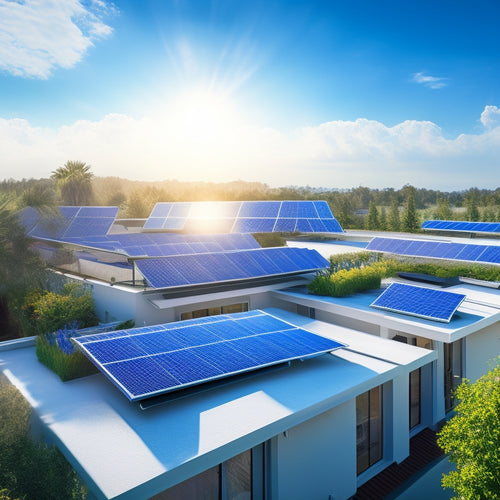
Why Simulate Solar Panel Systems Before Installation?
Share
By simulating your solar panel system before installation, you can minimize installation costs, optimize system design, and make data-driven decisions to enhance energy output and efficiency. Simulation helps identify potential errors, optimizes panel placement and angle, and identifies shading issues. It streamlines permitting and approval, reduces project timelines, and guarantees adherence to regulations. By simulating your system, you'll make informed decisions, reduce costs, and maximize energy production. As you explore the benefits of simulation, you'll discover how to optimize your system for peak performance and realize its full potential.
Key Takeaways
• Simulating solar panel systems before installation reduces errors and costs by identifying potential issues and optimizing system design for maximum ROI.
• Simulation enhances system performance predictions, identifying bottlenecks and inefficiencies to maximize energy production and efficiency.
• It optimizes panel placement and angle for maximum sunlight exposure, minimizing energy losses from shading, reflections, or thermal effects.
• Simulation identifies potential shading issues, predicting and mitigating risks from tree canopies and roof obstructions to ensure optimal system performance.
• By streamlining the permitting process, simulation saves time and resources, ensuring a smoother and more efficient installation process.
Reduces Installation Errors and Costs
By simulating solar panel systems before installation, you can greatly reduce the likelihood of costly rework and corrections, saving time and resources. This proactive approach allows you to identify potential errors and correct them before they become costly problems. By doing so, you can markedly decrease error margins, which can be detrimental to the overall performance and efficiency of your solar panel system.
A thorough cost analysis is also essential in identifying areas where costs can be minimized. By simulating different scenarios, you can determine the most cost-effective approach to your solar panel installation. This includes optimizing system design, component selection, and installation strategies to ensure maximum return on investment. By considering these factors, you can make informed decisions that reduce costs and maximize the overall value of your solar panel system.
Enhances System Performance Predictions
Through simulation, you can accurately predict your solar panel system's performance, including energy output, voltage, and temperature, allowing you to make informed decisions about system design and optimization.
By simulating your system, you can identify potential bottlenecks and inefficiencies, ensuring that your system operates at peak levels. This, in turn, enhances system reliability, reducing the likelihood of downtime and maintenance costs.
Additionally, simulation enables you to fine-tune your system's energy efficiency, maximizing energy production and reducing your carbon footprint. By predicting energy output and voltage, you can optimize system performance, ensuring that your solar panel system operates within a safe and efficient range.
This level of precision enables you to make data-driven decisions, ensuring that your system meets your energy needs while minimizing waste.
Optimizes Panel Placement and Angle
You can identify the ideal panel placement and angle by simulating various configurations, ensuring that your solar panels receive the maximum amount of sunlight and generate the highest possible energy output. This optimization is important for energy harvesting, as even slight deviations from the best angle can have a notable impact on energy production.
By simulating different panel orientations, you can:
-
Determine the most suitable panel angle to maximize energy output based on your location's solar irradiance
-
Identify the best panel orientation to minimize energy losses due to shading or reflections
-
Optimize panel placement to reduce energy losses from panel mismatch or thermal effects
Identifies Potential Shading Issues
When you simulate a solar panel system, you'll want to identify potential shading issues that can impact energy production.
By analyzing the tree canopy's impact and evaluating roof obstructions, you'll be able to pinpoint areas that may be affected by shade.
This information will help you optimize your system's design to minimize shading effects and maximize energy output.
Tree Canopy Impact Analysis
A tree canopy impact analysis accurately predicts potential shading issues by simulating the movement of the sun and the resulting shadows cast by surrounding trees onto your solar panel system. By considering factors like tree growth patterns and canopy density mapping, this analysis helps you identify areas where trees may obstruct sunlight and reduce energy production.
Here are some key benefits of a tree canopy impact analysis:
-
Accurate shading predictions: Get precise estimates of shading effects on your solar panel system, taking into account tree growth patterns and seasonal changes.
-
Optimized panel placement: Identify the best locations for your solar panels to minimize shading and maximize energy production.
-
Long-term performance forecasting: Predict how your solar panel system will perform over time, accounting for tree growth and canopy expansion.
Roof Obstruction Assessment
By simulating the roof's geometry and nearby structures, a roof obstruction assessment identifies potential shading issues that could impede energy production from your solar panel system. This assessment is essential in determining the feasibility of your solar panel installation.
By creating a digital replica of your roof's topology, you can identify potential obstructions such as chimneys, vents, and skylights that could cast shadows on your solar panels. Obstruction mapping allows you to visualize and analyze the impact of these obstructions on your system's energy output.
You'll be able to pinpoint areas where energy production might be compromised, enabling you to adjust your system design accordingly. With a roof obstruction assessment, you can optimize your solar panel layout to minimize shading effects, ensuring maximum energy production and a higher return on investment.
Streamlines Permitting and Approval
Your simulated solar panel system design accelerates the permitting and approval process by providing detailed, data-driven insights that facilitate smooth communication with local authorities. By leveraging simulation technology, you can guarantee that your solar panel system meets code compliance and adheres to government regulations, avoiding costly revisions and reducing the risk of project delays.
Here are some key benefits of simulating your solar panel system design:
-
Simplified code compliance: Simulation helps guarantee that your design meets local building codes and regulations, reducing the risk of non-compliance.
-
Streamlined permitting process: Detailed, data-driven insights facilitate smooth communication with local authorities, reducing the time and effort required to obtain necessary permits.
-
Reduced project timelines: By identifying and addressing potential issues early on, you can avoid costly revisions and reduce project timelines, getting your solar panel system up and running faster.
Mitigates Environmental Impact Risks
Through simulation, you can proactively identify and mitigate potential environmental impact risks associated with your solar panel system, guaranteeing a more sustainable and responsible installation. By analyzing your system's performance under various scenarios, you can minimize its carbon footprint and reduce the likelihood of environmental hazards. This is vital in the battle against climate change, as solar energy is a key element in the shift to a low-carbon economy.
Simulation helps you optimize your system's design to ensure maximum eco-friendliness, reducing the risk of environmental damage and promoting a more sustainable future. Additionally, simulation allows you to assess the potential impact of your system on local ecosystems, enabling you to take corrective measures to minimize harm. By mitigating environmental impact risks, you can be certain that your solar panel system not only generates clean energy but also promotes a healthier planet.
Supports Data-Driven Design Decisions
With simulation, you can make informed, data-driven design decisions for your solar panel system, guaranteeing peak performance and efficiency. By leveraging simulation, you can adopt a design thinking approach, where you can test and validate different design options, identifying the most efficient configuration for your specific use case. This data-driven approach enables you to make well-informed decisions, backed by high-quality data, rather than relying on assumptions or rules of thumb.
Some key benefits of simulation-driven design decisions include:
-
Optimized system configuration: Identify the most effective system design, taking into account factors such as panel orientation, inverter selection, and cable sizing.
-
Improved data quality: Ensure that your design decisions are based on accurate, reliable data, reducing the risk of errors or oversights.
-
Enhanced system performance: By testing and validating different design options, you can identify opportunities to enhance system performance, maximizing energy output and reducing costs.
Saves Time and Resources
By simulating your solar panel system before installation, you'll reduce the number of site visits needed, saving you time and resources. This means you can allocate your resources more efficiently, focusing on the most critical aspects of the project.
With simulation, you can identify and resolve potential issues before they become costly problems, streamlining your entire installation process.
Reduced Site Visits Needed
You can greatly reduce the number of site visits required for solar panel system installation by simulating the system beforehand, saving valuable time and resources. This is especially important for large-scale solar panel installations where multiple site visits can be costly and time-consuming. By simulating the system, you can identify potential issues and optimize the installation process, reducing the need for multiple site visits.
Some of the benefits of reduced site visits include:
-
Improved site planning: Simulation allows you to assess the site's suitability for solar panels, taking into account factors such as shading, orientation, and roof size.
-
Accurate cost analysis: By simulating the system, you can get a more accurate estimate of the installation costs, reducing the need for repeated site visits to gather information.
-
Enhanced collaboration: Simulation enables stakeholders to collaborate more effectively, reducing the need for multiple site visits to resolve issues.
Efficient Resource Allocation
Simulation enables efficient allocation of resources, guaranteeing that personnel and equipment are utilized efficiently, thereby saving time and resources. By simulating your solar panel system before installation, you can optimize your supply chain and budgeting strategies. This means you can allocate resources more effectively, reducing waste and minimizing delays.
| Resource | Simulation Benefit | Time/Resource Saved |
|---|---|---|
| Personnel | Identify the best crew size and skillset | 20% reduction in labor costs |
| Equipment | Ensure accurate tooling and machinery | 15% reduction in equipment rental fees |
| Materials | Optimize material quantities and delivery schedules | 12% reduction in material waste |
Improves Energy Output Projections
Accurate energy output projections are critical to determining the viability of a solar panel system, and simulating the system beforehand helps guarantee that your expectations are rooted in realistic data. By simulating your solar panel system, you can get an accurate estimate of the energy output, which is essential for energy forecasting. This allows you to make informed decisions about the system's design, size, and installation.
Here are some benefits of simulating your solar panel system:
-
Accurate energy output projections: Simulation helps you determine the exact amount of energy your system will produce, enabling you to make informed decisions about the system's design and installation.
-
Optimized system design: With accurate energy output projections, you can optimize your system's design to maximize energy production and reduce costs.
-
Increased Renewable Certificates (RECs): By accurately projecting energy output, you can increase the number of RECs you can sell, generating additional revenue.
Increases Customer Satisfaction Rates
When you simulate solar panel systems before installation, you can guarantee that your customers' expectations are met with accuracy, reducing the likelihood of misunderstandings and miscommunications.
By providing a precise simulation of their solar panel system's performance, you can improve communication channels and set realistic expectations.
This, in turn, leads to increased customer satisfaction rates, as clients are more likely to be happy with the results they receive.
Expectations Met With Accuracy
By accurately modeling a solar panel system's performance, you can guarantee that your expectations are met with precision, minimizing the likelihood of costly surprises during installation. This level of project realism fosters client trust, as you'll have a clear understanding of the system's capabilities and limitations. As a result, you'll experience increased customer satisfaction rates, as the system's actual performance aligns with your initial expectations.
Here are some key benefits of simulating solar panel systems before installation:
-
Accurate energy output projections: You'll have a clear understanding of the system's energy generation capabilities, ensuring that your expectations are met.
-
Realistic budgeting: By knowing exactly what to expect from your solar panel system, you can create a realistic budget and avoid costly surprises.
-
Enhanced client trust: By providing accurate projections and meeting expectations, you'll build trust with your clients and establish a strong reputation in the industry.
Improved Communication Channels
You can facilitate open and transparent communication with your clients by leveraging simulation data to set realistic expectations, ensuring that their needs are addressed throughout the installation process. By doing so, you'll establish clear expectations, which is essential in avoiding misunderstandings and ensuring a smooth project flow.
When you simulate solar panel systems before installation, you can identify potential issues and address them proactively, keeping your clients informed every step of the way. This leads to increased customer satisfaction rates, as clients appreciate the transparency and proactive approach.
Additionally, simulation data enables team alignment, ensuring that all stakeholders are on the same page. This alignment is vital, as it enables your team to work efficiently, minimizing errors and reducing the risk of costly rework.
Frequently Asked Questions
Can Simulation Results Be Used for Warranty and Insurance Purposes?
Like a detective searching for clues, you're wise to ask if simulation results can be used for warranty and insurance purposes. Yes, they can, as they facilitate accurate risk assessment and informed financial planning, giving you peace of mind.
How Does Simulation Software Handle Complex Roof Geometries?
When you simulate solar panel systems, you'll find that advanced software can accurately handle complex roof geometries by accounting for roof obstacles and geometric variations, ensuring precise energy output predictions and ideal system design.
Are Simulation Results Compliant With Local Building Codes and Regulations?
You guarantee code compliance by running simulations within a regulatory framework, verifying that your solar panel system meets local building codes and regulations, giving you peace of mind and a successful installation.
Can Simulations Be Used for Existing Solar Panel System Optimization?
You can leverage simulations to optimize existing solar panel systems, analyzing performance metrics to identify energy efficiency improvements, conducting system auditing, and scheduling maintenance to reduce operational costs, ensuring your system runs at its best.
Are Simulation Results Accurate for Systems With Energy Storage Systems?
When you simulate solar panel systems with energy storage, you'll find that accurate results rely on capturing complex energy dynamics, storage constraints, and system interactions, which requires advanced battery modeling and precise load profiles.
Related Posts
-

What You Need to Know About RV Solar Maintenance
When you're out on the road, your RV's solar panel system is your lifeline. But without regular maintenance, you're l...
-

What Are the Average Cost Savings of Solar Panels
You can expect to save between $400 and $1,000 per year on your electricity bills with solar panels, which translates...
-

Best Solar Panel Options for Maximum Energy Savings
You can maximize your energy savings with solar panels that boast efficiency ratings above 20%, paired with extensive...


